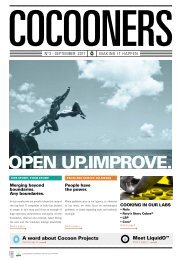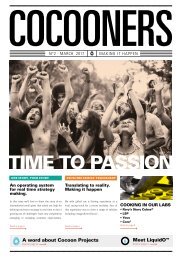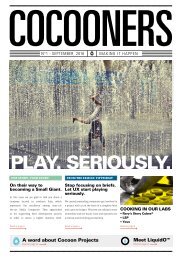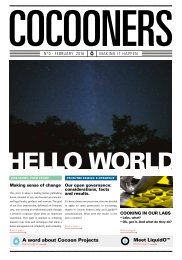COCOONERS - Making It Happen - No 6, March 2019
The digital version of our "Cocooners" half-yearly publication. Catch up about news, tools, thoughts, facts, people, work, future. Welcome to Cocooners. No 6, Mar 2019.
The digital version of our "Cocooners" half-yearly publication. Catch up about news, tools, thoughts, facts, people, work, future. Welcome to Cocooners. No 6, Mar 2019.
You also want an ePaper? Increase the reach of your titles
YUMPU automatically turns print PDFs into web optimized ePapers that Google loves.
Cocooners - n° 6 - <strong>March</strong> <strong>2019</strong><br />
MEET LIQUIDO <br />
What is LiquidO<br />
You might have heard of a new breed of organisational models, responding<br />
to the fast growing adaptability, engagement and collaboration needs<br />
within modern company structures. Or you might have simply experienced<br />
the sound problems of slowness, rigidity, bureaucracy, disengagement<br />
along with various kinds of waste and bottlenecks that “traditional”<br />
organisational models generate and suffer nowadays.<br />
This is what LiquidO TM is all about: the original “liquid organisation”<br />
model for governance, born from direct experience within Cocoon<br />
Projects and in use in a growing number of for profit and not-for-profit<br />
organisations willing to get liquid.<br />
Liquefying an organization means disrupting the industrial-age driven<br />
assumptions on which rigid structures are designed and move on to make<br />
it adaptive, dynamic and anti-fragile. Based on lean management and<br />
open collaboration principles, the LiquidO TM model is fluid,<br />
meritocratic and value-driven, enabling stigmergic<br />
behaviour and “organic” effectiveness.<br />
Why you would<br />
want it in your<br />
organisation<br />
Rigidly structured organizations<br />
cannot cope with the<br />
current pace of innovation<br />
and its complexity, let<br />
alone exploit it. We need a<br />
completely different mindset<br />
and consequently new models.<br />
And we need them to be simple<br />
and people-centric.<br />
This is exactly why LiquidO<br />
was born.<br />
1. Real-time adaptability.<br />
The industrial age organisational approach, where<br />
each area is defined as a restricted group of activities coherent<br />
to one another, has its biggest limitations in the risk to fall in fragmented,<br />
sealed administration and culture. As the company grows, so grows the<br />
complex ramification, branching and costs of these models. Lack of<br />
communication, heavy bureaucracy, disastrous efficiency.<br />
COLLABORATIVE<br />
WORKING BOARD<br />
REPUTATION<br />
TRACKING<br />
The completely different perspective realized by LiquidO, in fact relying<br />
on people and competences without fixed roles, provides an integrated<br />
and adaptive business management scenario shifted to a systemic<br />
approach, pragmatically meritocratic and inherently capable of real time<br />
adaptability to any context. <strong>It</strong>’s just like water, some would say.<br />
2. Better and faster information processing.<br />
Hierarchies are a sound bottleneck both for decision making and competences<br />
evolution. Too many info to process in order to succeed. Moreover,<br />
on the other hand, the distance between where and how in the organization<br />
strategies are created, and where and how they have to be executed<br />
too often creates waste, lack of effectiveness or even complete failure.<br />
<strong>No</strong>n-peer evaluation, silos and recruiting inefficiency are additional<br />
heavy side-defects of an organizational design philosophy based on the<br />
two illusions of control and predictability, and therefore actualized with<br />
structural divisions between thinking and doing.<br />
LiquidO is a viable and operational way to let all the brilliant people in<br />
the company effectively emerge. Anybody can join each wave, surf it and<br />
enrich it, so to say. And leveraging different viewpoints, backgrounds and<br />
competences today is definitely critical to succeed in taking better and<br />
faster decisions.<br />
CONTRIBUTION<br />
ACCOUNTING<br />
COLLABORATIVE<br />
DECISIONMAKING<br />
3. Engagement and spontaneous leadership.<br />
People are key in this picture. In fact, within<br />
LiquidO everyone can decide whether to<br />
join a process or not, try, and consequently<br />
determine her level by fast<br />
feedback loops from frequent and<br />
specific peer-reviews driven by<br />
the actual delivered value.<br />
Besides a natural engagement<br />
due to continuous feedback<br />
and consequently improving<br />
results, within this scenario<br />
it’s really difficult to deny<br />
emerging problems. Within<br />
the old way of thinking the<br />
organizations very often<br />
conflicts, work overload, sense<br />
of impotence, lack of decision<br />
power, absence of endorsement,<br />
unfair treatment and misalignments<br />
are among the real causes of failures.<br />
There is much more that can be done today, if<br />
only we let go of control, predictability and rigidity.<br />
LiquidO moves structures, processes and the organization<br />
itself away from the center, where it is assumed that people have to adapt<br />
to them, instead shifting the focus on people and truly empowering<br />
them to dynamically find their maximum value creation spot within<br />
the organization, expressing leadership effectively and without fear,<br />
naturally growing and being rewarded for this.<br />
Read the whole LiquidO whitepaper. <strong>It</strong> is available in<br />
Creative Commons at liquidorganisation.info<br />
16










